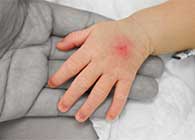Heel Fissures
Diabetic Neuropathy
What is Diabetic Neuropathy?
Neuropathy Affecting The Feet
Advice on Cutting Your Toenails
Symptoms of Neuropathy Affecting Your Feet and Hands
Heel Fissures
Charcot Foot
Wrong Sized Shoes
Neuropathy and Antidepressants
Diabetic Holiday Foot Syndrome
Patient and Family Carer Experience
Diabetes and Hearing Loss May be Due to Neuropathy
Gastroparesis
Heel Fissures
The Isle of Wight Diabetes Monitoring Group, kindly gave permission for IDDT to reprint an article in their magazine, Sweet Pea. The article is by Oliver Davies, Senior Diabetes Chiropodist.
What are heel fissures?
Heel fissures are a common occurrence in all the population, but in diabetes they can cause serious problems if they are not dealt with effectively. They are essentially cracks or splits in the skin often extending through to the dermis [the inner layers of the skin] and are often painful when pressure is applied to the heel on standing. They can frequently bleed and once the fissure opens it is often difficult to get the two edges of the split to knit back together.
With so many people with diabetes suffering from neuropathic damage [causing loss of feeling, commonly in the feet] these fissures often go unnoticed until they have become quite severe. Frequently they can become infected, and where many people with diabetes can suffer with ischaemia [a reduced blood supply] they are subsequently difficult to heal and may ulcerate.
What causes heel fissures?
Invariably heel fissures are symptomatic of dry skin conditions. Loss of innervation [nerve supply] to the sweat glands in the feet can result in people with diabetes having drier skin than the rest of the population. Hot weather, wearing of sandals, inadequate skin care, abrasive hosiery, poor circulation and possibly some forms of medication can all contribute to the drying of skin.
How can I prevent heel fissures?
Generally, after washing or a short soak of the feet, the application of a good moisturing cream should be sufficient to keep skin more supple and hence prevent their formation. The cream should be applied every day, particularly if you have been instructed to do so by your chiropody/podiatry clinic. The Podiatry Department often recommend Aqueous Cream B.P. which is a water based cream that helps to rehydrate the skin [and not just in the feet!] Basically, you can use any moisturising cream providing it is done on a regular basis!
How do I deal with a heel fissure already present?
If on your daily foot inspedtion you discover a crack in the heel, keep a close eye on the area and initiate the daily moisturising routine maybe 2 or 3 times a day. If there is no improvement after a week it is advisable to contact your local Chiropody/Podiatry Clinic and let them assess it and advise you. At the clinic they will be able to apply suitable dressings to heal the fissure and suitable padding materials to prevent the inevitable shoe rubbing that might prevent them healing.
Remember if in doubt about any foot problems always contact your local chiropody/podiatry clinic for advice.




































